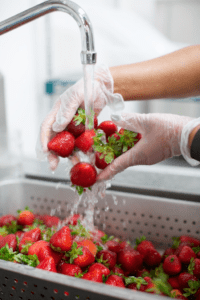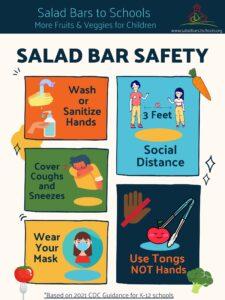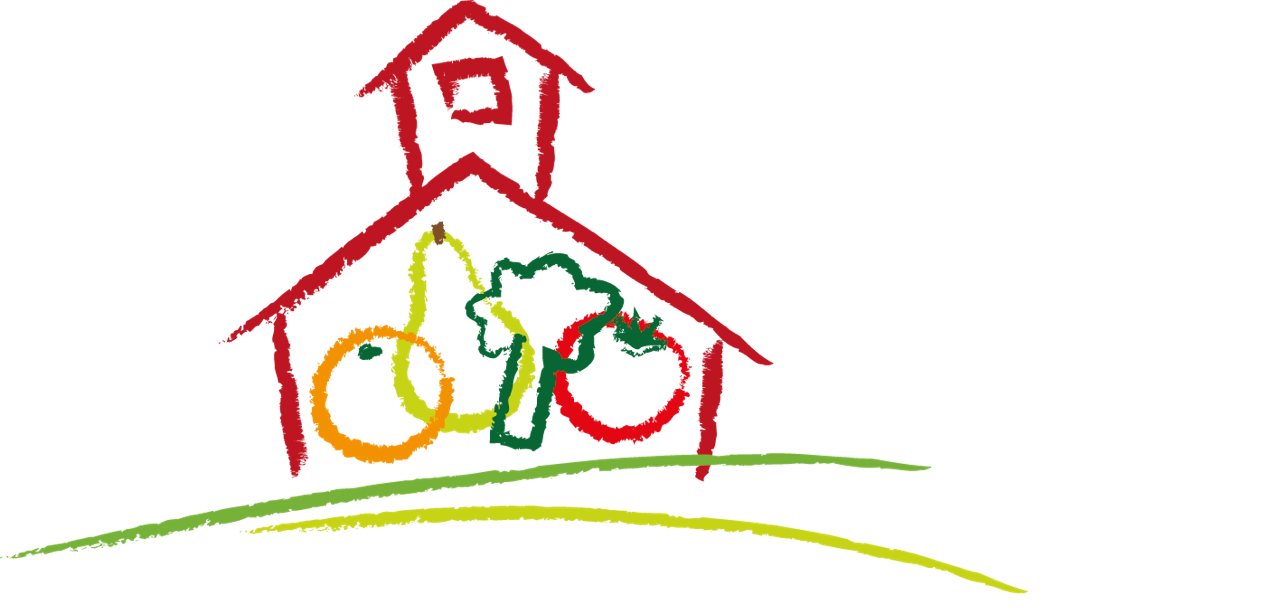Salad Bars During Covid: School Year 21-22

This school year, like last year, brings both new challenges, and new opportunities. With school meals free to all students again this year, and more pre-packaged and processed foods being served to schools due to the pandemic, it’s more important than ever to serve fresh fruits and vegetables, and cooked-from-scratch meals whenever possible. During these challenging times, salad bars continue to change the culture of school cafeterias and present new prospects for students to learn and engage with school meals. Salad bars ensure that all children have consistent access to the fresh, whole foods needed to foster lifelong healthy eating habits and maximize future potential.
Salad Bars to Schools (SB2S) understands that many of you are working through the creation and implementation of multiple school learning plans and feeding program options, and that during this time things are constantly evolving. We also know that districts and schools have struggled with deciding whether to open their salad bars for service this year. We are all trying to do what is best for our communities and do not want to take any risks with the health of our children and their families. Currently, the Centers for Disease Control and Prevention (CDC) is recommending that schools work with local public health officials to determine if salad bars are approved for use depending on the status of their communities. As part of their most recent recommendations for School Food Service, the CDC states, “Given very low risk of transmission from surfaces and shared objects, there is no need to limit food service approaches to single use items and packaged meals.”
SB2S recognizes that these are not normal circumstances, and that the decision to keep a salad bar in operation in this environment is a district’s choice, and we respect any decision your district chooses to make. For the schools and districts that will be able to operate their salad bars this school year we have compiled some updated resources based on the latest guidance from the CDC, including communication templates, sample SOPs, new salad bar safety signs, and stories of salad bar super heroes from food service directors around the country who are going above and beyond to bring salad bars back for this school year!
Thank you for all the hard work you do every day to bring healthy meals to children in your community!
Current Recommendations for School Food Service
Currently, (last update 8.5.21) the CDC is recommending that schools work with local public health officials to determine if salad bars are approved for use depending on the status of their individual communities. All current CDC recommendations for school food service can be viewed HERE, with some of the recommendations available below:
- Given very low risk of transmission from surfaces and shared objects, there is no need to limit food service approaches to single use items and packaged meals.
- Staff should wear masks at all times during meal preparation and service, and during breaks except when eating or drinking.
- Students should wear masks when moving through the food service line.
- Maximize physical distance as much as possible when moving through the food service line and while eating (especially indoors). Based on studies from 2020-2021 school year, CDC recommends schools maintain at least 3 feet of physical distance between students.
- Clean frequently touched surfaces. Surfaces that come in contact with food should be washed, rinsed, and sanitized before and after meals.
- Staff: Promote hand washing before, after, and during shifts, before and after eating, after using the toilet, and after handling garbage, dirty dishes, or removing gloves.
- Students: Teach and reinforce hand washing with soap and water for at least 20 seconds.
- If hand washing is not possible, use hand sanitizer containing at least 60% alcohol (for teachers, staff, and older students who can safely use hand sanitizer). Hand sanitizers should be stored up, away, and out of sight of young children and should be used only with adult supervision for children under 6 years of age.
Staff Training
Training staff is fundamental to salad bar program success. Salad bars represent a significant service model shift for any district. To prepare the team, the director should provide training that includes how the salad bar impacts the menu plan, product ordering and preparation, setting up and breaking down the bar, and addressing meal service with a salad bar.
 To learn more about training your staff and students check out the SOPs, Training, & Support section on The Lunch Box, as well as the following resources:
To learn more about training your staff and students check out the SOPs, Training, & Support section on The Lunch Box, as well as the following resources:
- Check out The Lunch Box’s Salad Bar Training Video for a quick and informative video on salad bar implementation including washing & preparing fresh fruits and vegetables for the salad bar and salad bar food safety.
- Educate yourself and your staff in the management and preparation of salad bars using the School Food Institute’s comprehensive online Salad Bar course, for an in-depth look at planning and assessment for salad bar implementation, as well as the complex operational issues of recipe development, production records, and procurement.
Standard Operating Procedures (SOPs)
We strongly believe that salad bars are the best option for increasing fresh fruit and vegetable options in school lunch. We also believe that salad bars, if supported by the proper Standard Operating Procedures (SOP), as outlined by the CDC, are safe in school meal programs (in areas where they are approved by state and or local health authorities for SY 21-22).
 Here are some sample HACCP Standard Operating Procedures related to salad bars that can be modified for your program:
Here are some sample HACCP Standard Operating Procedures related to salad bars that can be modified for your program:
- Salad Bar Covid SOP – Salad Bars to Schools
- Viral Pandemic Response -Institute of Child Nutrition (ICN)
- Washing Fruits and Vegetables– ICN
- Preventing Contamination at Food Bars- The Lunch Box
- Cleaning and Sanitizing Food Contact Surfaces – ICN
Student Training
 Just as staff should be trained on the proper health standards for salad bars, students should also be trained in salad bar safety & health measures and how to properly build a meal using the salad bar. Below are educational resources from SB2S and our partners to help communicate with students and ensure the safe use of salad bars.
Just as staff should be trained on the proper health standards for salad bars, students should also be trained in salad bar safety & health measures and how to properly build a meal using the salad bar. Below are educational resources from SB2S and our partners to help communicate with students and ensure the safe use of salad bars.
- Salad Bar Signs –Salad Bar Safety During Covid
- Full Size Poster (English) – Salad Bars to Schools
- Individual Signs (English) – Salad Bars to Schools
- Student Training Videos: We also encourage districts to check out these amazing student salad bar training videos created by food service departments around the country where the students are the trainers to provide examples on how you could make a training video tailored to your own school! These videos were not created by salad Salad Bars to Schools, and are just examples that each cater towards the individual districts programs. Try making your own video using students from your district and be sure to incorporate the latest CDC (as well as state and local) guidance such as wearing a mask, social distancing, and proper washing/sanitizing hands before using the salad bar. Kids love to learn from their peers, and vice versa, kids also love to teach their peers. It’s a win-win!
- Student Salad Bar Training Video #1- Fullerton School District, CA
- Student Salad Bar Training Video #3- Fairfax County Public Schools, VA
Be sure to include cafeteria volunteers and regular lunchroom supervisors (e.g. vice principals, aides, teachers) in the training with students as they are important to the overall follow-through of salad bar procedures, and can be of great assistance with monitoring the salad bar for safety, and assisting students during lunch time. By educating them on proper use of the salad bar, you can ensure long-term success of the program.
Communication
As students and staff are trained on health and safety procedures for salad bars, schools should communicate their strategies and any changes to teachers, staff, students and families, using accessible materials and communication channels. These communications should be in a language and at a literacy level that teachers, staff, students, and families understand.
- SB2S created downloadable sample letters you can use to communicate with families about salad bars and the upcoming school year:
- Salad Bars are Back during Covid, Letter to Families – Salad Bars to Schools
- New Salad Bar During Covid, Letter to Families – Salad Bars to Schools
- For tips on improving your school food program’s communication materials take a look at: Recommendations for Communicating with Parents and Students About School Meals created by No Kid Hungry for SY 21-22.
- Use our Top 10 Reasons Your School Should Have a Salad Bar for talking points in your communication channels. Gaining support from the entire school community will be essential for the success of all salad bar programs.
Salad Bar Success
- Full Service Salad Bar in Guernsey, Wyoming
Dawndrea Daly, Food Service Coordinator for Platte County #2 district in Guernsey, Wyoming, with her innovative and determined mindset was able to keep her salad bar open during the last school year (SY20-21). With a plexiglass front and a dedicated staff member who builds a salad from items chosen by each student, she found a way to safely continue using a salad bar to benefit her students. Daly was awarded her salad bar through Chef Ann Foundation’s Salad Bars To Schools Grant in 2018. Thanks for being a salad bar superstar Dawndrea Daly! Read more about Daly’s program courtesy of School Meals that Rock Blog, here.
- Giles County Public Schools Salad Bar: Virginia
Salad bars are currently open for the new school year for the public high schools in Giles County, VA! Food Service Supervisor Christy Lawson says students will maintain as much social distance as possible as they move through the cafeteria lines, will wash their hands AND wear gloves while at the salad bar. GCPS has also gone back to being able to offer students more scratch cooked meals this school year! Great work Giles County! Read the article to learn more about GCPS current school meal program.
If your school is finding creative ways to make salad bars available this school year, we would love to hear about it! Email us here: info@saladbars2schools.org
We hope this information and these resources will continue to support districts in the implementation and reintroduction of school salad bar programs. For more resources regarding salad bars visit https://www.saladbars2schools.org/ and The Lunch Box Resource Library under the topic “Salad Bars”.
